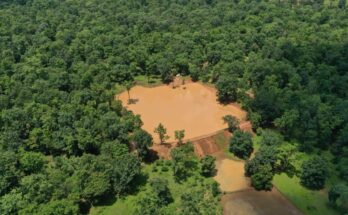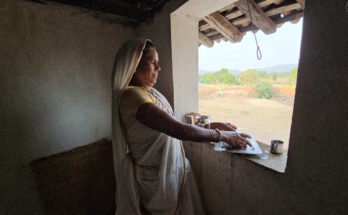Raipur. The customs, traditions and culture of the tribals of Bastar in Chhattisgarh have global fame. Compared to other states of the country, the lifestyle of the tribals of Bastar is quite different and full of curiosity. The mention of Devgudi inevitably comes up in the discussion of the tribals of Bastar. There is a Devgudi in every village and panchayat in the tribal areas here. Devgudi is the temple of the family deity of the regional tribals, in whom their faith is unwavering. The Vishnudev Sai government of the state has taken a strong step in protecting the tribal culture by renovating hundreds of old Devgudis in the highly Naxal-affected areas.
Devgudi is an important part of the forest areas of Chhattisgarh. The Chief Minister of the state Vishnu Dev Sai has also described Devgudi as an important part of the culture, because these centers of faith are the preserve of the primitive culture. These ancient heritages are also symbols of Indianness in a very deep way. The preservation and promotion of such Devbhumi (land of Gods) which are the carriers of faith is very important and now special efforts are being made in that direction by CM Vishnudev Sai.

Determined to fulfill the Prime Minister’s guarantee and to improve Chhattisgarh, the state’s successful Chief Minister Vishnudev Sai has ordered the concerned departments to take this work forward and take effective steps in this direction. It has also been emphasized that the participation of the local community should also be ensured in this pious work. Conservation of Devgudis is in the interest of the forest dwellers in many ways because not only is cultural heritage being preserved but it is also promoting regional tourism.
Tourists coming from far off places to Devgudis are getting acquainted with the various cultures, civilization, food habits, lifestyle, ornaments and dialects of the tribals. Due to Devgudi Darshan, for the first time, tourists are getting such an opportunity where apart from knowing and recognizing the civilization and culture of the tribal region, they are able to feel it closely. Due to the automatic promotion of tribal style through tourists, it has started getting a different identity on the world stage, due to which tribal culture is becoming more prosperous.

There are hundreds of Devgudi areas like Bhangaram, Dokari Mata Gudi, Semriya Mata, Lohjarin Mata Gudi, Mawali Mata Gudi, Maa Danteshwari Gudi and Kanchan Devi Gudi in the forest-rich tribal areas of Chhattisgarh. So far, more than 1,200 Devgudi sites have been documented and preserved by the concerned department. All these Devgudis hold a special place among the local tribal communities. Apart from being an integral part of the cultural heritage and ecological wealth of the state, Devgudi is revered by the tribal communities. These sites are the abode of tribal deities as well as the center of traditional rituals and festivals. In many ways, Devgudi is also a unique center of biodiversity.
On the directions of the head of the state, Chhattisgarh Forest Department, Joint Forest Management, CAMPA, Chhattisgarh State Biodiversity Board and State Forest Research and Training Institute are engaged in the conservation of these sacred Devgudis. Chief Minister Vishnudev Sai and Forest Minister Kedar Kashyap both belong to the forest-rich tribal areas of Chhattisgarh and under their leadership, the Forest Department is engaged in the conservation of Devgudi sites. The effort to conserve Devgudis is also indirectly forest management and biodiversity conservation.

There is a tradition of keeping a garden along with the Devgudi and these gardens are very important botanically.. These gardens also provide shelter to local and endangered botanical species.. Now these gardens are also being protected with the government’s efforts.. Conservation of the gardens of Devgudis also indirectly helps in preventing soil erosion. Tribal communities believe that the gods themselves protect these holy places. Traditionally, cutting trees, hunting or harming any living creature is prohibited in Devgudis.. These gardens of Devgudis are also the cultural identity of the tribal communities because they keep their traditional practices alive.
Special rituals of festivals like Madai, Hareli and Dussehra are performed in these Devgudis and their gardens associated with tradition, it is here that the newly married couples of the tribals come and receive the blessings of the local gods.
Keeping in mind the environmental and cultural importance of the Devgudi sites among the local tribal communities, the forest department is carrying out special construction works here, so that the Asthavan forest dwellers can get additional facilities. The construction works include the construction of footpaths, fencing and structures to protect the environment. Along with the renovation and repair of the Devgudis, their old paintings are also being re-carved, and
arrangements are being made as per the need. As per the need, new sheds are being constructed in the Devgudis. The stones of the Devgudi are being decorated in a very beautiful way through paintings. As far as possible, places are being made for the villagers to stay in these Dev Sthals. A grand fair is also being organized every year in many of the fully prepared Devgudis.
The priests of the Devgudi are also looking very happy with this initiative of the state government. According to them, no efforts were made before this for the renovation of these Devgudis. Now, after the construction of Devgudi, it has become very good for the villagers and now people are coming from distant places to see this Devgudi.

The Forest Department is taking all possible support from the local tribals in the active conservation and promotion of Devgudis. Along with the conservation of Devgudis, the Forest Department is also planting a large number of local plant species. At the same time, efforts are also being made to revive the traditional festivals of the forest dwellers. To revive the biodiversity of the groves of Devgudis, the Forest Department is planting native species like Sal, Teak, Bamboo, Haldu, Baheda, Sulfi, Amla, Banyan, Peepal, Kusum Bel, Saja, Tendu, Bija and many medicinal plants. The groves of Devgudis are a suitable place for the life of wildlife like snakes, peacocks, wild boars and monkeys.
Devgudis also play an important role in promoting this trend of tribal communities who are traditionally against deforestation.
The Devgudi sites of Chhattisgarh are being officially registered in the People’s Biodiversity Register of the National Biodiversity Authority. Research work is also being done to document the biodiversity of the sacred groves of Devgudis. However, in today’s situation, the groves of Devgudis are facing many threats like urbanization, encroachment,
weeds, grazing of animals, collection of firewood from the forest, but despite all these challenges, the Chhattisgarh Forest Department is fully committed to preserving their biodiversity and cultural importance.
Chief Minister Vishnu Dev Sai has considered the Devgudi sites located in the forest-rich tribal areas of Chhattisgarh as the cultural heritage of the state and is emphasizing on the conservation and promotion of these sites. Today, these Dev Sthals have started developing very fast as regional tourism. The efforts of Chief Minister Vishnu Dev Sai and the Forest Department in the conservation and promotion of the Devgudi sites of Chhattisgarh will be remembered for thousands of years to come.




